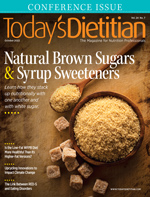 Ask the Expert: When to Toss Moldy Food
Ask the Expert: When to Toss Moldy Food
By Toby Amidor, MS, RD, CDN, FAND
Today’s Dietitian
Vol. 24 No. 7 P. 10
Q: When should clients toss food that’s moldy?
A: Although most molds found on food are spoilage microorganisms, meaning they’ll spoil the food but not necessarily lead to illness, some molds can cause allergic reactions and respiratory issues. In addition, under the right conditions, several molds produce mycotoxins, which are poisonous substances that can cause illness. Below you’ll discover more about mold, when to cut mold off food, and when moldy food should be discarded.
Understanding Mold
Molds are microscopic fungi that live on plant or animal matter. Most are filamentous organisms and produce spores, which are a characteristic of fungi. The spores can be transported by air, water, or insects. Most molds consist of a body with the following three parts: root threads that invade the food it lives on, a stalk that rises above the food, and spores that form at the ends of the stalks. It’s the spores that give the mold their hue. Molds have branches and roots that appear as thin threads. The roots can grow deep into the food and can be difficult to see. Foods that are moldy also may carry microscopic bacteria that are growing together with the mold.1
Molds aren’t only on the surface of the food, although they may appear as a green or white circle in cheese or gray fur on pastrami. When a food has heavy mold growth, the root threads are deeply imbedded in the food. In pathogenic molds, poisonous substances typically are found in and around the threads and toxins may have spread throughout the food.
Some people may see mold on food and refrigerate the food to help minimize growth. However, although most molds prefer warmer temperatures, they also can grow at refrigerator temperatures. Molds also tolerate salt and sugar better than other microorganisms such as bacteria.
What Foods to Discard
The following foods should be discarded when mold is found on them, as foods with high moisture content can be contaminated below the surface. Moldy foods also may have bacteria growing along with the mold.
• luncheon meats, bacon, or hot dogs;
• cooked leftover meat and poultry;
• cooked casseroles;
• cooked grains and pasta; and
• yogurt and sour cream.
Clients should throw away soft cheese (eg, cottage cheese, cream cheese, Neufchâtel, chèvre, Bel Paese), crumbled, shredded, and all types of sliced cheeses if they have mold, as foods with high moisture content can be contaminated below the surface. Shredded, sliced, or crumbled cheese can be contaminated by the cutting instrument. Moldy soft cheese also can have bacteria growing along with the mold. Clients also should toss cheeses made with mold (eg, Roquefort, blue, Gorgonzola, Stilton, Brie, Camembert), if they become moldy.
If jams and jellies have mold, clients should discard them, since the mold could be producing a mycotoxin. Experts recommend against scooping out the mold and using the remaining condiment.1 Soft fruits and vegetables, such as cucumbers, peaches, and tomatoes, have high moisture content and can be contaminated below the surface. Breads and baked goods with mold also should be discarded, as porous foods can be contaminated below the surface. Lastly, peanut butter, legumes, and nuts with mold should be discarded, as foods processed without preservatives are at high risk of mold.
When to Slice Away the Moldy Area
There are several instances in which individuals can cut around the moldy area, especially in dense food where it’s difficult for the mold to penetrate. Since the mold roots can’t penetrate harder foods, the USDA recommends cutting a certain distance around the roots so the food will be safe to eat.
• Hard cheese (not cheese where mold is part of the processing): Cut off at least 1 inch around and below the mold spot (keep the knife out of the mold itself so it won’t cross-contaminate other parts of the cheese). After trimming off the mold, re-cover the cheese in fresh wrap.
• Firm fruits and vegetables (eg, cabbage, bell peppers, carrots): Cut off at least 1 inch around and below the mold spot.
Recommendations for RDs
Nutrition professionals should discuss with clients how to store food properly to avoid mold growth. Education also should be provided to clients, especially high-risk populations, on potential toxins found in mold, why it’s important to discard certain foods with molds, and when it’s acceptable to cut around the moldy spot.
— Toby Amidor, MS, RD, CDN, FAND, is founder of Toby Amidor Nutrition (tobyamidornutrition.com) and a Wall Street Journal bestselling author. She’s written nine cookbooks, including Diabetes Create Your Plate Meal Prep Cookbook: 100 Delicious Plate Method Recipes and The Family Immunity Cookbook: 101 Easy Recipes to Boost Health. She’s also a nutrition expert for FoodNetwork.com and a contributor to U.S. News Eat + Run and other national outlets.
Reference
1. Molds on food: are they dangerous? USDA Food Safety Information website. https://www.fsis.usda.gov/sites/default/files/media_file/2021-02/Molds_on_Food.pdf. Updated August 2013.
